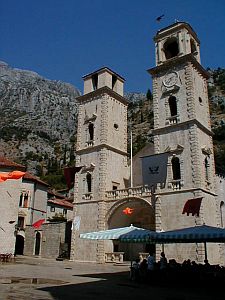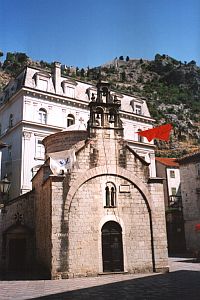Official Name
Котор (Kotor). The Venetian respectively Italian name is Cattaro. Once there was a Greek colony called Akurion. The Romans changed the name into Acruvivium. The present name seems to derive from the old old names.
Location
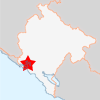
| ||
| Kotor in Montenegro |
Kotor is located at the Montenegrin Adriatic Sea coast, but not directly. Actually it's located at the head of the long Бока Которска (Boka Kotorska, boka=bay). See the chapter on →surroundings for more information. The small capital of Montenegro is called Подгорица (Podgorica) and is around 80 km away further to the east. The famous Croatian town of →Dubrovnik in the north-west is almost 100 km away. In and around Kotor, there's not much space between the up to 1,700 metres high mountains and the see. As in →Croatia, →Bosnia and →Slovenia, Karst characterises the landscape.
Population
Kotor is a rather small town and has about 25,000 inhabitants. Only few of them live in the old town centre.
Orientation
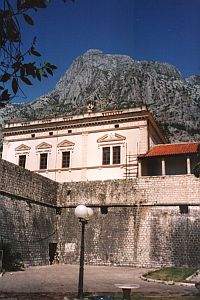 | ||
| Kotor: The walls of the old town |
Kotor is clearly divided into the old town and the new town. Kotor Bay in the west and steep mountains in the east limit the space. In the northern part, there's a small and short canal. The newer districts start beyond the canal. The entire old town is surrounded by massive walls and therefore very easy to find. The almost triangular historic centre is very compact. South of the centre and only a few hundred metres away, there's the bus station. From there it's only a few minutes walk to the main gate. The city walls are separated from the seashore by a busy road (state road No 2).
History
Kotor is a very old town and has its own distinctive history. Illyrians founded a first settlement here during the 3rd century BC and named it Teuta. Later on, Hellenes followed. Eventually, Romans took over and fortified the town. Wide parts of the Balkans were raided by Huns, Avars and othet tribes, but thanks to its hidden location, Kotor was rarely destroyed. However, the Byzantine Empire managed to take the town and continued what the Romans have started - to develop Kotor into a military stronghold.
During the 12th century, Kotor became an important harbour town within Serbia. It also developed into a cultural centre. From the 15th to the 18th century, Venetia (Venice) ruled Kotor and the area around the town. Due to the fact that the area was under a permanent threat from the Ottoman empire, Kotor was more and more fortified. After the 18th century, Habsburg ruled Austria annexed Dalmatia and Kotor, using it as an important military base. Caves at the seashore near Kotor were used as a submarine base. Yes, Austrian submarines!!! Unfortunately, nothing has been heard of their colleagues, the Dutch mountain infantery.
Kotor was too fortified to be taken by force let alone to be destroyed. Which is obviously a good thing. But nature did what man failed to do: The town was partially destroyed by heavy earthquakes in the 16th and 17th century. The last destructive quake took place in 1979. After that, the UNESCO took notice of this marvellous town, declaring the entire old town and the fortification systems an (endangered) World Cultural Heritage. This makes it easier to allow intensive reconstruction work.
Getting there / transportation
Kotor is not connected to the railroad, so the only way to get there is by bus. →Dubrovnik is a perfect base for going to Kotor and other places along the sea coast. From Dubrovnik, direct buses run to the border crossing at Karasovići, where passengers have to change the bus. The whole trip costs 71.50 Kuna (€ 10, single trip). Prices are substantially cheaper in Montenegro. The bus from Kotor to Igalo near the border costs € 1.5 only. By the way - the people drive like madmen, passing in the craziest places. Be careful when you get around on your own vehicle - especially when it's got two wheels only.
When you arrive at the bus station, the first thing you will think about is how to get away from this place as quick as possible. The bus station and all the other buildings around look very drab. Things will change dramatically when you walk towards the old town. After some hundred metres, the impressive city wall comes into view. All in all, the walls are almost five kilometres long. However, it not only surround the town centre but also include the steep hill behind the town. The town has its back to the wall so to say. The wall was built along the ridge. The highest point is characterised by San Giovanni Fortress, offering a splendid view over the town itself and a part of Kotor Bay (unfortunately we missed the chance to climb the mountain). The wall is up to 20 metres tall and in some parts 15 metres wide. There are three important gates: The Northern and the Main (facing the waterfront) Gate were built during the 16th century. The Southern Gate, also known as Gurdich-Tor, is the oldest and by far the most beautiful gate. It dates back to the 9th century.
|
|
For many centuries, Kotor has been the centre of a Roman-Catholic as well as of a Greek-Orthodox diocese. And so it doesn't come as a surprise that Kotor is dotted with churches. Probably the most famous one is known as Катедрала Светог Трифуна у Котору Cathedral of St Trychon (aka Triphon). This Romanesque church was built in 1166 on the top of an old temple. The church was severely damaged by the earthquake in 1979, but the damage is not visible from outside. There are other Romanesque buildings in the old town - among them St Lucas Church, which was built during the 12th century as well.
|
|
Kotor offers a nice cross-section of architectural styles. Apart from Romanesque buildings, you will also find many Baroque, Renaissance, Gothic and other buildings and elements. Most of the buildings within the city walls were built between the 12th and the 14th century. There are two larger squares in the old town, making it easy to orientate. Close to the main gate and facing the long square in the western part, there's also a tourist information.
As for the rest, the old town consists of a network of more or less narrow lanes. And - there are almost no tourists! This of course might change within several years. Yet, it's a hot tip and definitely worth a visit. Kotor is a little bit like the small version of Dubrovnik, but without all the to-do.
Kotor is located at the south-east head of Бока Которска Boka Kotorska (Italian: Bocche di Cattaro). Kotor Bay is several dozen kilometres long and it's shape is rather complicated. At three places, the opposite seashore is only a few hundred metres away. But if you want to go to the other side by car, it takes hours. As you can see on the picture, the bay is completely surrounded by steep, barren mountains. Technically, this bay is a fjord - in Southern Europe! A very strange sight. The water seems to be very shallow, but there must be a deep lane in the middle - else, it wouldn't have been used as a submarine base. Hidden in the upper part of the fjord, you will see two small islands appearing like a fata morgana. That's Свети Ђорђе (St George Islet), fully occupied by a monastery (?), and Госпа од Шкрпјела Gospa od Skrpelya.
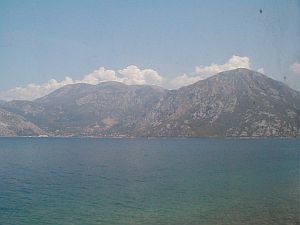
| ||
| Boka Kotorska (Kotor Bay) |
Not far from the mouth of the bay, several well-known seaside resorts such as Херцег-Нови (Herceg Novi) and Игало (Igalo) line up along the coast. There you will find countless hotels, pensions, camp sites and more. During the summer months, half of Serbia seems to holiday. Not surprisingly: After the end of the war in Croatia, many Serbs avoid the Dalmatian coast. The Montenegrin coast is different to the Dalmatian coast, but it's beautiful, too. However, foreign tourists are still rare.
Unfortunately we didn't have the time to stay overnight. But there seem to be some pensions. Accommodation can be arranged by the tourist information. Most visitors seem to stay in one of the holiday resorts further to the west.
- www.idk.cg.yu/tour Virtual tour through the city. In English and Serbian.
- www.kordic.info Excellent website of a photographer from Kotor. Several beautiful pictures of the town can be seen in Collections/Architecture/St Tryphone. English.
- www.unesco.org/csi/act/dure UNESCO website about Kotor. Contains information on the reconstruction program and recent problems.
- www.matf.bg.ac.yu/konferencije/kotor Nice website and photos about the sights. English.
- www.pantucek.com/cat_kotor1.htm Many nice pictures and short explainations in German.
Do you have or do you know a good website about Kotor? Don't hesitate, let me know! After checking it, I would love to add it to the link list. You can submit a link by using the →contact form. Note that commercial websites will be treated differently.
©2024 Europe-East.com

 Albania
Albania Montenegro
Montenegro